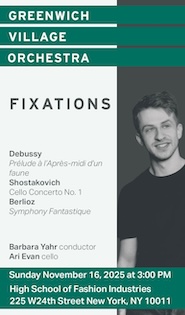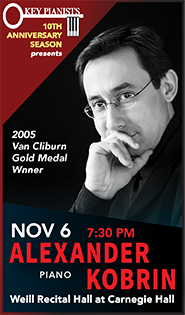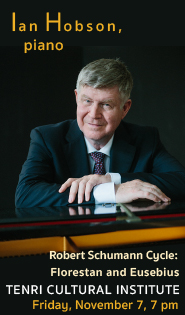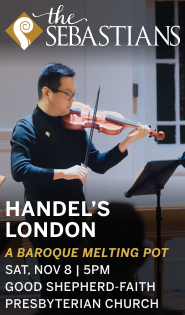Ambitious Babbitt series opens in intriguing but uneven fashion

Julia Glenn gave the world premiere of Milton Babbitt’s “Concerti” with the New Juilliard Ensemble Friday night. Photo: Richard Termine
Juilliard’s annual FOCUS! series opened Friday night with the first concert of “Milton Babbitt’s World: A Centennial Celebration.” Babbitt’s world was expansive and complex–essentially the entire 20th century–and the first night set Babbitt amid his peers, and hinted at his legacy.
The programming—which all week long will mix music by Babbitt and myriad composers—came from Joel Sachs, FOCUS! director and producer, and conductor of the New Juilliard Ensemble. That group is the core band for the series, and Friday they were augmented by a handful of talented young soloists.
The concert opened and closed with Babbitt; The Crowded Air and the world premiere of his Concerti for Violin, Orchestra, and Synthesized Sound. His wider world was represented by music from former Babbitt students Jonathan Dawe and Ursula Mamlok, and with works by his peers Alexander Goehr and Stefan Wolpe.
Compact and ideally energetic, The Crowded Air was written in tribute to Elliott Carter, on that composer’s 80th birthday. In brevity and concentration, it’s an excellent introduction to Babbitt’s work. Built around permutations of the A minor triad, there is a clearly discernible structural girder running through all the simultaneous activity. Unfortunately, the performance was indistinct, lacking punch and confidence.
Things took off with Dawe’s Déploration sur la mort de Milton Babbitt, heard in its world premiere. Originally written for full orchestra, Dawe reduced it for a chamber-sized group for this series. That version seemed ideal for what the music does. In the program notes Dawe described a compositional process that wove together fragments of Babbitt, Schoenberg, and Renaissance composers, while utilizing techniques he learned from Babbitt.
While this throws up warning signs of both pastiche and personal obsession, the music is organic, with a voluptuous sound. Brief moments of tonal cadences drift in and out of complex, translucent textures. The playing had both concentration and a sense of musical pleasure, and the music sounded both anguished and celebratory.
Goehr’s Verschwindendes Wort (Vanishing World) also was heard in its world premiere. This is a fascinating set of songs—with mezzo-soprano Jacqueline Horner-Kwiatek and tenor Andrew Fuchs—and instrumental preludes. The textual and musical sensibility is a delineated yet opaque mysticism; the poems explore metaphysical origins of language, with each settings etching the words into a piping lyricism. The preludes are through-composed and quizzical. The playing had both concentration and a sense of musical pleasure, and the music sounded both anguished and celebratory.
The combination of mystery and transparent musical language compels attention—as did the edgy, controlled performance—even as the core meaning remained a puzzle. This was one of the best kind of musical experiences, where one wants to hear the music repeated and get closer to the mystery at the center.
Stefan Wolpe’s Chamber Piece No. 2 for 13 Players, which opened the second half, has some of that quality as well. Written late in his life, when medication ameliorated his Parkinson’s, so that Wolpe could again work, the piece is brief, with minimal materials and lots of space. It’s also full of quick thoughts and reactions, and yet feels expansive.
Wolpe’s style, a skillful, learned mix of the range of 20th century music from pop songs to atonality, is challenging to pin down, especially his late music. Closest to works like Chamber Piece No. 2 is Carter’s late style, but where Carter is aphoristic and socially exuberant, Wolpe’s language is more logical and elegant to hear. The concluding drum solo, little more than a roll, is a just-so presentation of information with an elusive meaning.
Undergraduate oboist Hugo Lee joined the ensemble for Mamlok’s Concerto for Oboe and Chamber Orchestra. His playing was technically excellent and conveyed that this dense music made sense to him. Here too though, the ensemble sounded less confident, reacting to what was happening rather than anticipating it, holding on to the form and structure rather than expressing it.
As for the Babbitt premiere, Concerti is completed but felt unfinished. The score was literally lost. Babbitt had written the piece for violinist Isidor Lateiner—Sachs speculated in the program that the reason the piece was never played was that Lateiner could not find an ensemble, and Babbitt was only able to realize a little over five minutes of the tape accompaniment (although he had notated the entire thing in preparation).
When Lateiner died in 2005, the score went to his brother Jacob, a member of the Juilliard piano faculty and a score collector. After Jacob’s death, the (unpublished) score was auctioned off and Juilliard bought it. Subsequently, it turned out that Babbitt’s daughter, Betty Ann Duggan, had the tape.
With the tape and Babbitt’s notations, Dawe finished the electronic part, which now could be played live through electronic keyboards and percussion—in an odd bit of authenticity, the performance began with the tape and switched over to the live playing. But while every note is available, Babbitt never had the chance to evaluate how the music should work live, and what might need changing and adjusting.
Concerti sounds like Babbitt, with a linear flow of constant activity, a susurration and burping of vintage analog sounds, tight coordination of rhythms and phrases. It has his trademark quality of density and delicacy, like a field of spiderwebs.It also has so little space in between instruments and events that it feels claustrophobic, and there’s hardly any change in dynamics.
One can imagine Babbitt happy to hear Julia Glenn’s exacting approach to the solo line, and the concentrated attention of the ensemble’s playing. And then one can picture him going back to his studio to bring a final version out of these materials.
“Milton’s Babbitt’s World: A Centennial Celebration” continues through January 29 events.juilliard.edu






